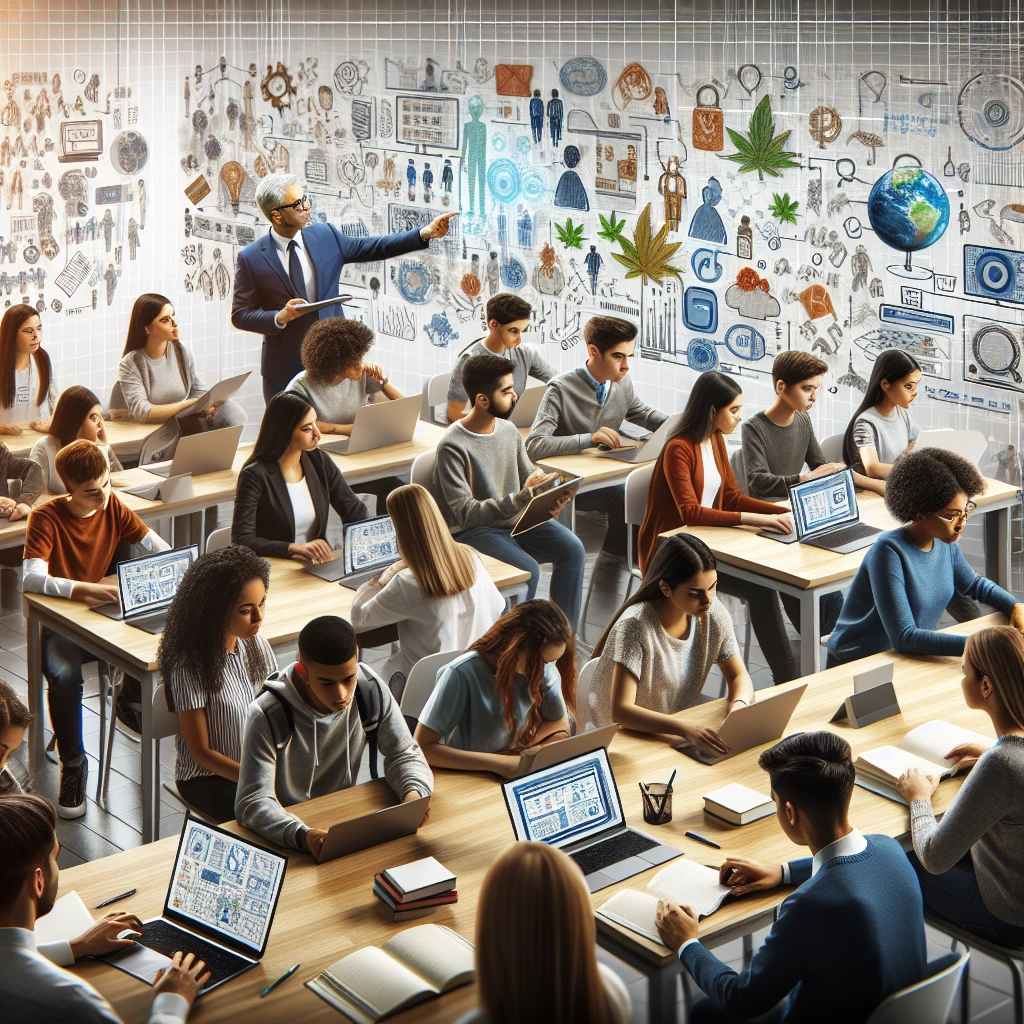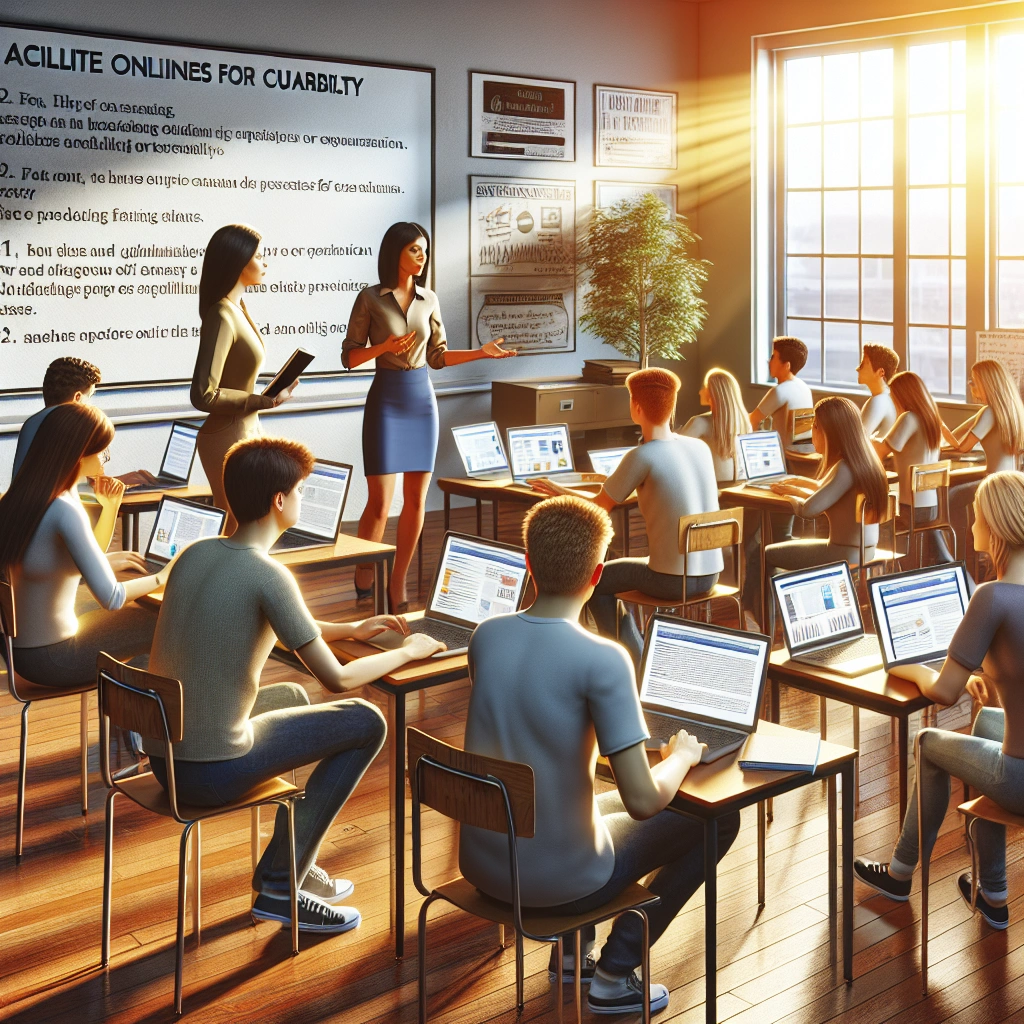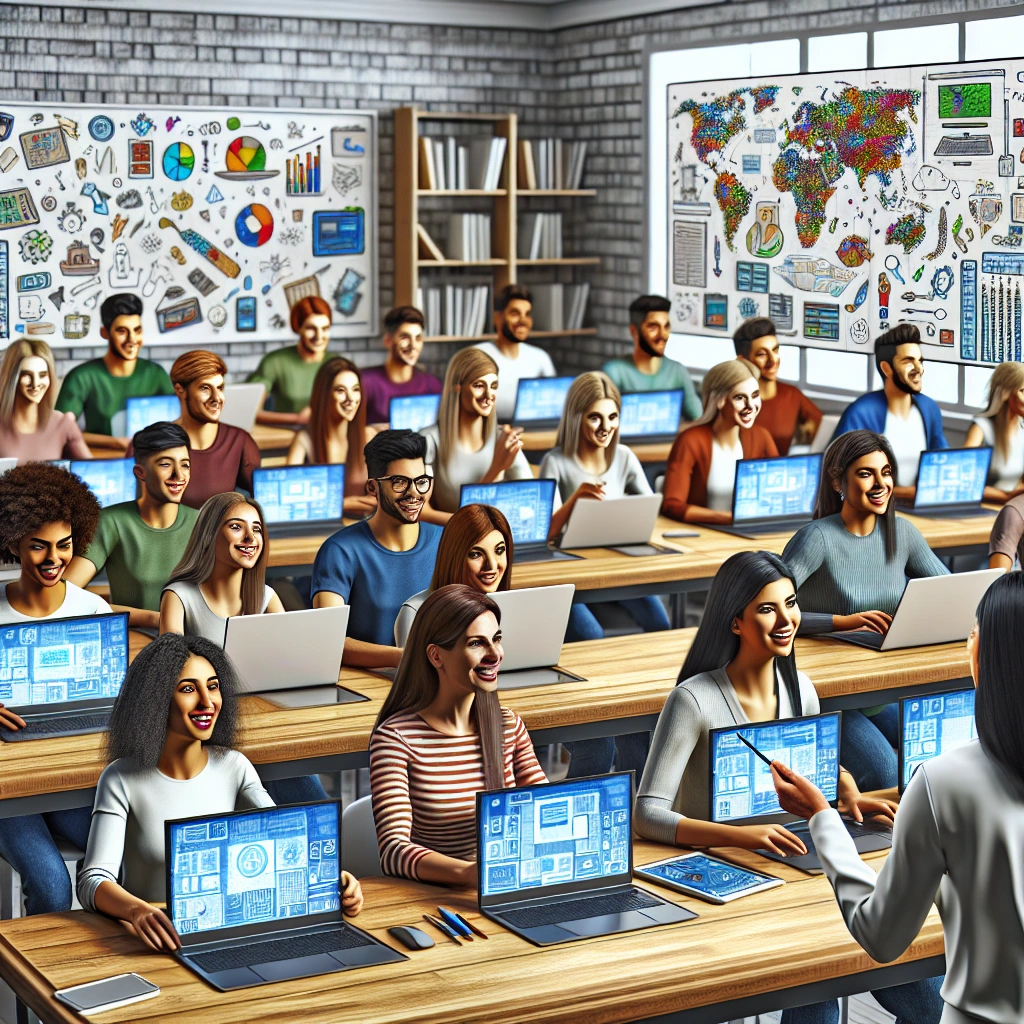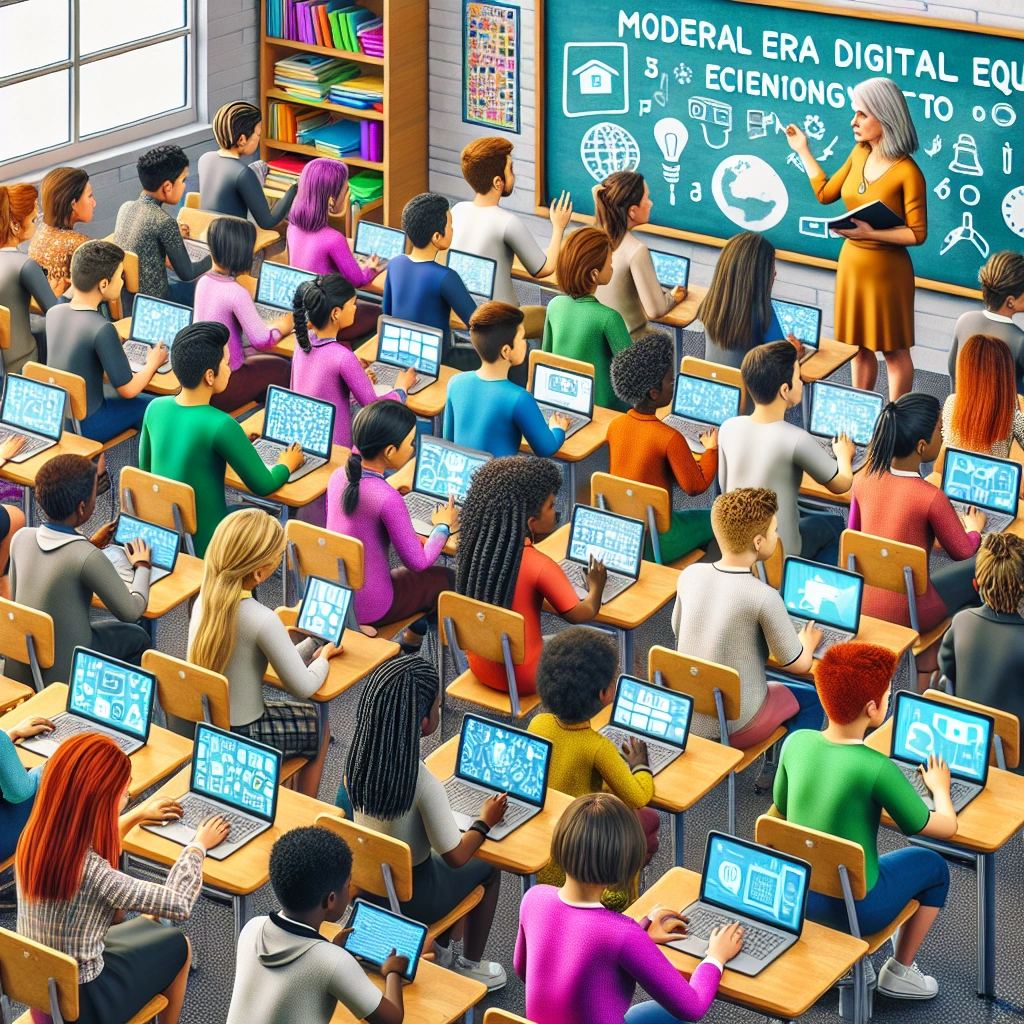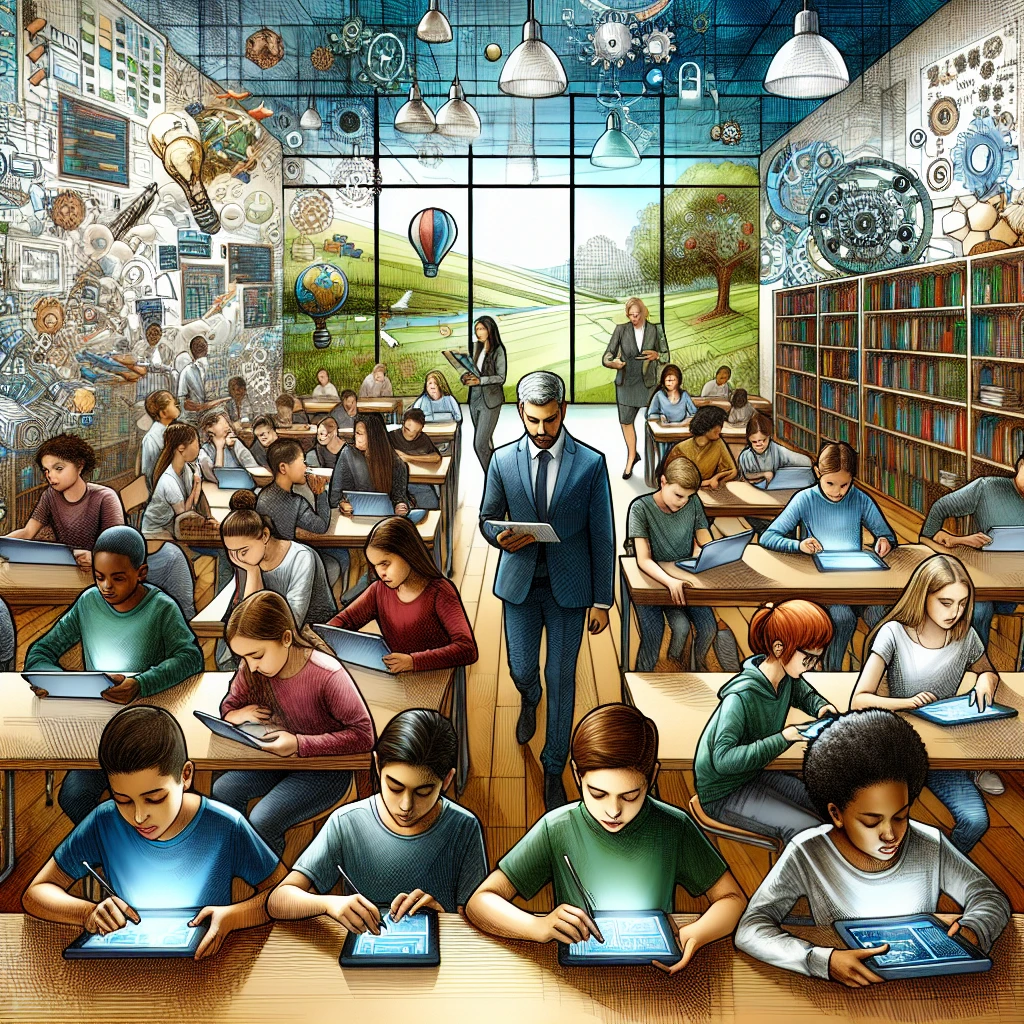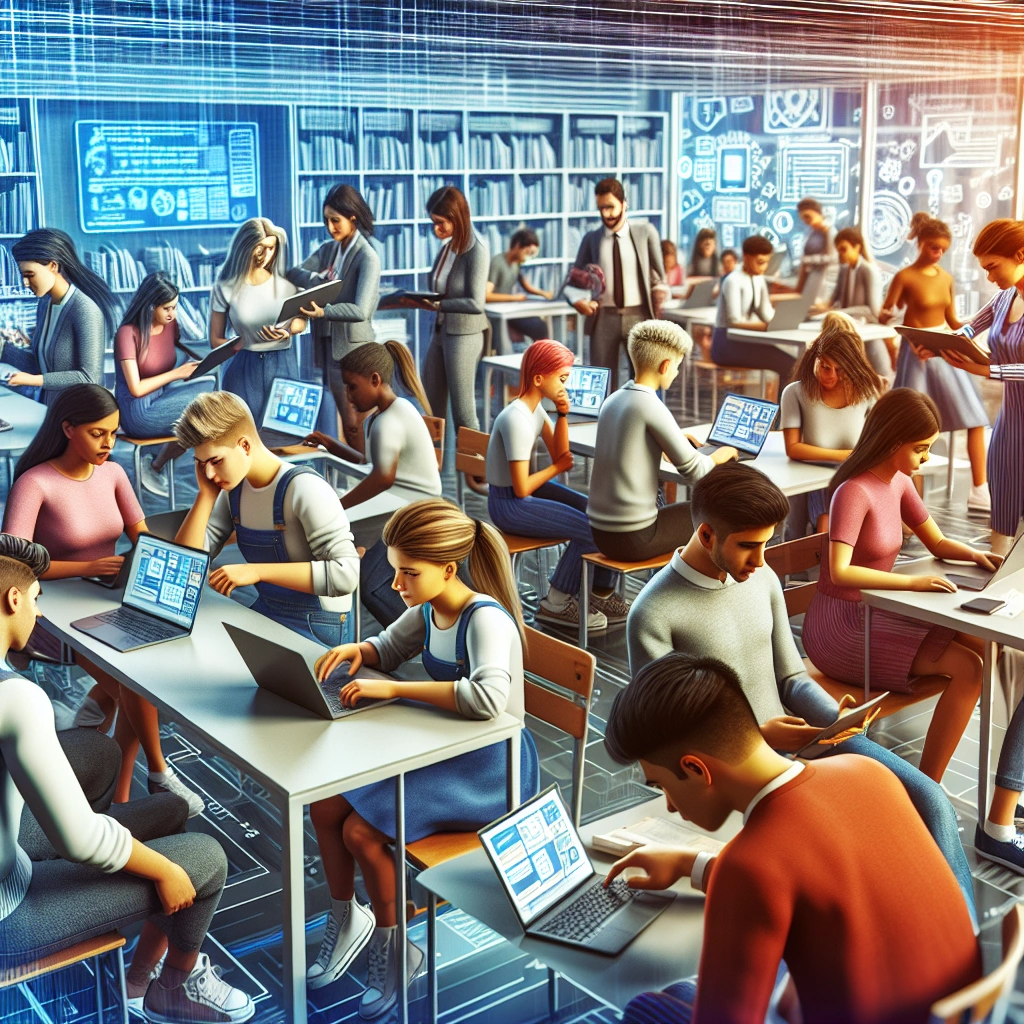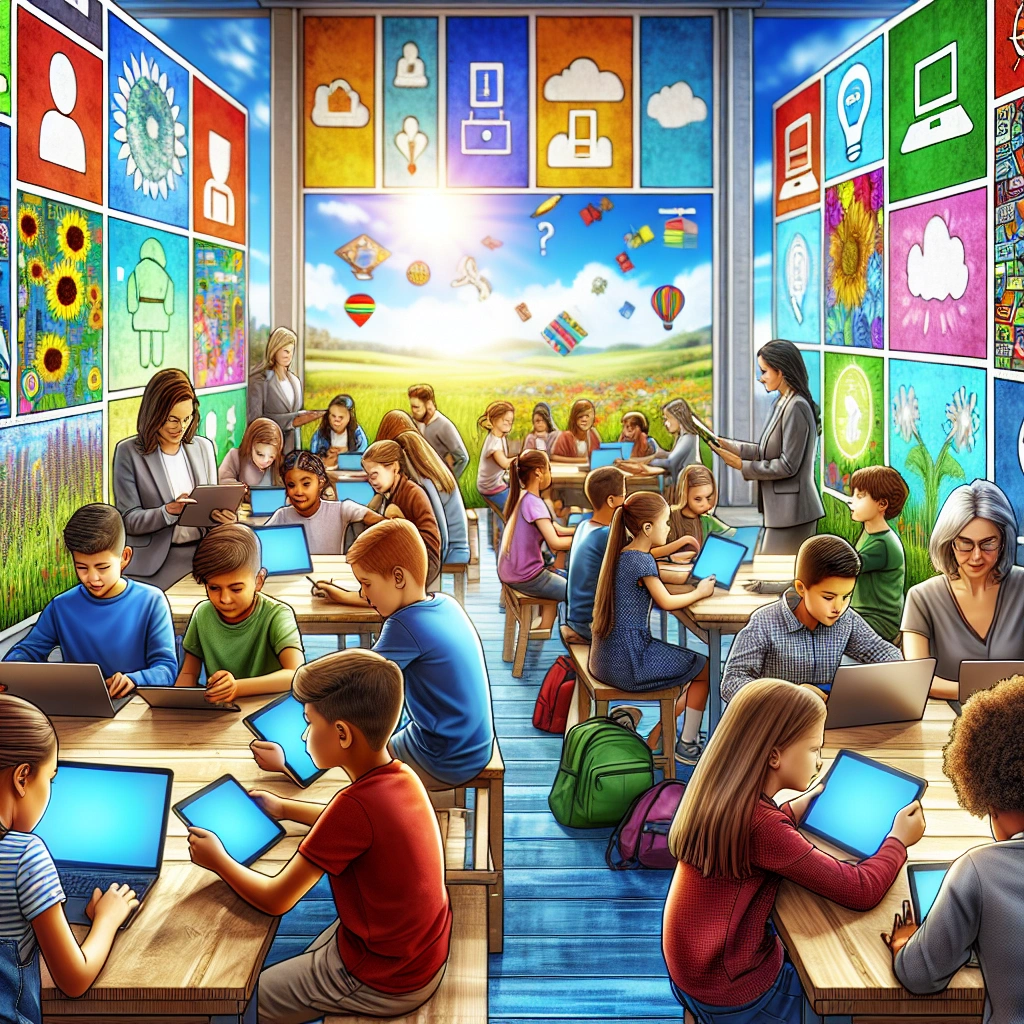How Are Digital Literacy Skills Incorporated Into School Curriculums Related: Importance & Implementation


Digital literacy skills are the ability to navigate, evaluate, and create information using digital technology. In the modern world, these skills are crucial for success in education, employment, and daily life.
Incorporating digital literacy skills into school curriculums is essential to prepare students for the digital demands of the 21st century.
By integrating digital literacy skills into school curriculums, students can develop the technical, civic, communicative, collaborative, computational thinking, investigative, and productive skills needed to thrive in a digital society. This ensures that students are prepared for the digital challenges they will face in their academic and professional lives.
Additionally, digital literacy in school curriculums can support educational progress and enable students to use technology as a powerful toolset to expand their learning opportunities.
Incorporating digital literacy skills into school curriculums is vital for ensuring that students are equipped to navigate the digital world, improve academic performance, and develop the critical thinking and problem-solving skills necessary for success. It is important for educators to recognize the importance of digital literacy and integrate it into their teaching practices to help students become proficient and responsible digital citizens.
Check out this Youtube video to learn how digital literacy skills are incorporated into school curriculums and how they can be taught across different subjects to enhance student learning and success:
The Evolution of Digital Literacy in Education
Historical background of digital literacy in school curriculums
Digital literacy in school curriculums has evolved from basic computer skills to a more comprehensive understanding of digital tools, information management, and online safety. Initially, it focused on computer literacy and basic IT skills, but it has now expanded to encompass competencies such as critical thinking, media literacy, and ethical digital behavior.
Changes and developments over the years
Over the years, digital literacy in school curriculums has witnessed significant changes, especially with the increasing reliance on technology in education. Schools have adapted to incorporate digital literacy skills into various subjects, teaching students how to evaluate online information, discern fake news, and use digital tools for research and collaboration.
Moreover, there has been a shift towards integrating coding and programming skills into the curriculum, empowering students with the ability to create and innovate in the digital space.
The Importance of Incorporating Digital Literacy Skills in School Curriculums
Advantages of integrating digital literacy skills into education
Digital literacy skills hold immense advantages in education. They empower students to access a wide range of educational resources, enabling them to conduct in-depth research and enhance their learning experiences.
Additionally, integrating digital literacy skills fosters critical thinking, problem-solving, and creativity, essential attributes for students to thrive in the modern digital age. Furthermore, it equips students with the ability to discern credible information from the vast amount of data available online, nurturing a sense of digital responsibility.
Impact on students’ future success
The incorporation of digital literacy skills into education significantly impacts students’ future success. By mastering these skills, students are better prepared for the professional landscape, where digital fluency is increasingly crucial.
They develop the capacity to adapt to new technologies seamlessly, enhancing their employability and career prospects. Moreover, digital literacy empowers students to effectively communicate, collaborate, and present their ideas, building essential skills for success in their future endeavors.
| Advantages | Impact on Students’ Future Success |
|---|---|
| Access to educational resources | Better prepared for the professional world |
| Fosters critical thinking and creativity | Enhanced employability and career prospects |
| Develops digital responsibility | Improved communication and collaboration skills |
Digital literacy skills integrated into school curriculums offer students a myriad of advantages and contribute significantly to their future success in a digitally-driven society.
Curriculum Design and Digital Literacy Integration
Strategies for developing a curriculum that includes digital literacy skills
To develop a curriculum integrating digital literacy skills, educators need to focus on practical applications. For example, incorporating coding and computer programming in math classes allows students to understand concepts like algorithms and problem-solving.
Moreover, integrating digital storytelling in language arts helps students enhance their communication skills while utilizing digital tools. By aligning digital literacy with real-world applications, students can develop critical digital skills essential for their future.
Aligning digital literacy with existing subject areas
Aligning digital literacy with existing subject areas involves identifying synergies between disciplines. For instance, incorporating data analysis and visualization tools in science classes enables students to understand and interpret scientific data efficiently.
Similarly, integrating digital research and information literacy with social studies helps students navigate and critically evaluate online information. By weaving digital literacy into existing subject areas, students can develop essential skills while enhancing their learning experiences.
Teacher Training and Support for Digital Literacy Implementation
Ensuring educators have the necessary skills to teach digital literacy
To ensure educators have the necessary skills to teach digital literacy, a comprehensive training program should be implemented. This will involve workshops focusing on practical digital tools, interactive teaching methods, and strategies to incorporate real-life examples of digital literacy.
For example, providing hands-on training on educational apps, online resources, and cybersecurity essentials can equip educators with the skills to effectively teach digital literacy.
Professional development opportunities
Professional development opportunities are crucial in keeping educators updated with the latest trends in digital literacy. Workshops, seminars, and webinars tailored to address digital literacy challenges should be integrated into the curriculum.
These opportunities should aim to enhance educators’ knowledge about online safety, digital communication, and ethical use of technology. Additionally, partnerships with tech companies and industry experts can bring valuable insights and expertise to support educators in their digital literacy journey.
These opportunities should aim to enhance educators’ knowledge about online safety, digital communication, and ethical use of technology. Additionally, partnerships with tech companies and industry experts can bring valuable insights and expertise to support educators in their digital literacy journey.
| Digital Literacy Training Activities | |
|---|---|
| Webinars | Workshops |
| Seminars | Online resources |
| Educational apps | Cybersecurity essentials |
By ensuring educators have the necessary skills and providing ongoing professional development opportunities, schools can effectively incorporate digital literacy into their curriculums, enabling students to thrive in an increasingly digital world.
Digital Literacy Tools and Resources for the Classroom
Overview of different tools and resources available for teaching digital literacy
Digital literacy can be effectively taught using a variety of tools and resources. Utilizing educational platforms like Google Classroom, teachers can offer interactive lessons and assignments, while software such as Adobe Spark enables students to create engaging multimedia projects.
Additionally, online research databases like JSTOR and EBSCO provide a wealth of academic resources for teaching digital literacy skills.
Examples of successful implementation
One remarkable instance of successful implementation is the integration of coding programs like Scratch and Tynker into the curriculum, allowing students to develop foundational programming skills. Furthermore, the use of educational websites such as Khan Academy for digital skill tutorials has proven highly effective.
Incorporating real-life scenarios through applications like Google Earth enhances students’ digital literacy by providing practical, hands-on experiences.
| Tools/Resources | Successful Implementation |
|---|---|
| Google Classroom | Interactive lessons |
| Adobe Spark | Multimedia projects |
| JSTOR, EBSCO | Research databases |
| Scratch, Tynker | Coding programs |
| Khan Academy | Skill tutorials |
| Google Earth | Real-life applications |
These examples illustrate how diverse tools and resources can effectively nurture digital literacy skills in the classroom, ensuring students are well-prepared for the digital age.
Assessing Digital Literacy Skills in Students
To evaluate students’ digital literacy competencies, schools can employ various methods. They can utilize established tools like the Digital Literacy Assessment (DLA) by Northstar or the Digital Competence Test (DCT) by ECDL.
Additionally, educators can create their own assessment tools using platforms such as Google Forms, Kahoot, Padlet, or WordPress. These platforms allow for customized assessments tailored to specific curriculum goals and student needs.
Incorporating assessments into the curriculum involves defining clear learning outcomes and selecting appropriate assessment methods. Furthermore, constructive feedback, rubrics, and criteria play crucial roles in effectively assessing digital literacy skills.
Educators must ensure that assessments are integrated seamlessly into the curriculum to continuously address and develop students’ digital literacy capabilities.
| Assessment Methods | How to Incorporate into Curriculum |
|---|---|
| Digital Literacy Assessment (DLA) by Northstar | Integrate into lesson plans and activities |
| Digital Competence Test (DCT) by ECDL | Customize assessments to align with curriculum objectives |
| Google Forms, Kahoot, Padlet | Utilize for tailored assessments to assess digital literacy skills |
Addressing Digital Equity and Access
Ensuring all students have equal access to digital literacy education
To ensure all students have equal access to digital literacy education, it is crucial to address the digital divide by providing internet and technology access to underserved communities. This can be achieved through initiatives such as community broadband access, support for one-to-one take-home technology, and promoting digital literacy.
By implementing these strategies, we can bridge the gap and create a level playing field for all students to access digital resources and education.
Overcoming barriers to technology access
Barriers to technology access, such as internet or computer access, budget constraints, and scarcity of curricula, need to be addressed to ensure equitable access to technology in education. By providing support for bring-your-own-device (BYOD) programs, encouraging community broadband access, and offering technical support, we can overcome these barriers and ensure that every student has the opportunity to benefit from digital learning resources.
| Strategies for Promoting Digital Access and Equity |
|---|
| 1. Support 1:1 Take-Home Technology |
| 2. Support Community Broadband Access |
| 3. Encourage BYOD |
| 4. Support Digital Literacy |
| 5. Go Online |
| 6. Address all three components of access simultaneously through interconnected strategies |
By implementing these strategies, educational institutions can work towards closing the digital divide and providing equal opportunities for all students to access digital literacy education.
Collaborating with Parents and the Community
Involving parents and the community in supporting digital literacy education
Collaboration with parents and the community is essential for supporting digital literacy education in schools. Parents can reinforce media literacy messages at home, creating a powerful partnership for helping children become effective cybercitizens.
By involving parents in digital literacy education, families can collectively create a safe and supportive online learning environment where responsible digital behavior is practiced.
Building partnerships with local organizations
Schools can also build partnerships with local organizations to integrate digital literacy into existing programs. By mapping existing community resources and offering small grants, schools can encourage the integration of digital technology into educational initiatives.
This partnership approach fosters the development of pathways to digital learning partnerships and advances digital equity for all students.
Adapting to Technological Advances
The educational landscape is rapidly evolving with technological advancements. In today’s learning environment, it’s crucial to keep curriculums aligned with the latest technology trends to enhance student engagement and learning outcomes.
By incorporating emerging technologies such as augmented and virtual reality into the curriculum, educators can create immersive learning experiences that cater to diverse learning styles. These advancements not only align education with the digital age but also foster a more interactive and dynamic learning environment.
Amidst the technological progress, it’s essential to strike a balance between traditional literacy and digital literacy. While incorporating digital literacy skills, educators must ensure that traditional literacy skills such as reading, writing, and critical thinking are equally emphasized.
This balance enables students to harness the benefits of digital tools while also developing crucial foundational skills that are timeless and essential for holistic learning. By integrating digital creation activities alongside traditional literacy practices, students can explore the digital realm while appreciating the value of traditional literary pursuits.
| Traditional Literacy | Digital Literacy |
|---|---|
| Reading books | Evaluating digital content |
| Writing skills | Creating digital content |
| Critical thinking | Digital research skills |
Adapting to technological advances in education involves embracing emerging trends while preserving the timeless value of traditional literacy skills. By striking this balance, educational institutions can prepare students for the digital age, equipping them with a well-rounded skill set that encompasses both traditional and digital literacy.
So, to answer the user’s query without beating around the bush: The incorporation of digital literacy skills into school curriculums is crucial for preparing students for the digital age, but it’s equally important to maintain a balance with traditional literacy skills to ensure a holistic learning experience.
Preparing Students for the Digital Workforce
Aligning digital literacy education with future career opportunities
Digital literacy education must align with future career opportunities to ensure that students are equipped with the necessary skills for the rapidly evolving digital workforce. This entails integrating practical and forward-thinking digital literacy programs that not only focus on basic technical skills but also on critical thinking, problem-solving, and adaptability, which are crucial for success in modern careers.
Teaching skills that are relevant to the modern workforce
Teaching skills relevant to the modern workforce involves incorporating digital literacy into the curriculum and learning outcomes in a comprehensive manner. This may include fostering competencies in data analysis, cloud computing, augmented reality, and virtual reality, as identified by the World Economic Forum.
Additionally, educators should emphasize skills such as critical thinking, self-management, and stress tolerance, which are essential for thriving in the digital landscape.
Overcoming Challenges in Implementing Digital Literacy in School Curriculums
Common obstacles and how to address them
-
Lack of Proper Resources: Many schools face the challenge of inadequate resources such as computers, internet access, and digital learning materials. To address this, partnerships with technology companies and community organizations can provide access to essential resources, while seeking funding through grants and government programs can alleviate financial constraints.
-
Resistance to Change: Some educators may resist integrating digital literacy into the curriculum due to a lack of understanding or fear of technology. To counter this, offering comprehensive training and professional development programs for teachers can foster confidence and competence in utilizing digital tools for education.
-
Digital Divide: Socioeconomic disparities can lead to unequal access to technology at home, affecting students’ ability to engage in digital learning. Implementing initiatives to provide devices and internet access for underprivileged students can bridge this gap and ensure equitable opportunities for all.
Examples of successful solutions
-
California Digital Divide Project: By partnering with major tech companies, California launched a project to provide internet access to students in underserved communities, successfully overcoming the digital divide challenge.
-
Digital Literacy Training for Teachers: In Scandinavia, successful integration of digital literacy into school curriculums was achieved through robust teacher training programs, empowering educators to adapt to digital teaching methodologies effectively.
-
Public-Private Partnerships: In urban areas of the United States, public-private partnerships have facilitated the provision of digital learning resources to schools, mitigating resource-related obstacles in implementing digital literacy.
| Obstacle | Solution |
|---|---|
| Lack of Proper Resources | Forming partnerships and seeking funding |
| Resistance to Change | Offering comprehensive teacher training |
| Digital Divide | Initiating initiatives for student access |
Demonstrating the Impact of Digital Literacy Education
Stories of students benefiting from digital literacy skills in their education
In a recent study, 93% of students demonstrated improved critical thinking and problem-solving skills due to digital literacy education. For example, Sarah, a high school student, utilized digital skills to create a compelling presentation on climate change, inspiring her classmates to take action.
Additionally, John, a college senior, credited his digital literacy expertise for landing a competitive internship at a leading tech company, showcasing the tangible impact of such skills on students’ educational journeys.
Moreover, research by experts at Cambridge University highlighted how digital literacy empowered students to access a world of information, enhancing their learning experiences and academic performance. These stories underscore the vital role of digital literacy in equipping students with the necessary skills to excel in modern educational settings.
Long-term outcomes and success stories
Long-term success stories abound, with recent graduates attributing their career readiness and adaptability to digital literacy skills acquired during their academic pursuits. Notably, a study by CSIS revealed that digital literacy made graduates more agile and employable in the ever-evolving job market, emphasizing the enduring impact of such skills on future professional endeavors.
Furthermore, a literature review spanning two decades showcased the profound influence of digital literacy on students’ learning achievement. The study emphasized how improved digital literacy, accelerated by the shift to online learning during the COVID-19 pandemic, directly correlated with enhanced academic performance and career planning, reinforcing the significance of digital literacy for long-term educational success.
| Digital Literacy | Impact on Education |
|---|---|
| Critical thinking enhancement | Improved academic performance |
| Career readiness | Employability and adaptability |
With these compelling success stories and long-term outcomes, it’s evident that integrating digital literacy into school curriculums not only benefits students during their academic journey but also sets them on a trajectory for long-term success in the digital age.
This table demonstrates the tangible impact of digital literacy education in empowering students for academic and professional success.
Remember, digital literacy isn’t just a subject to be taught; it’s a skill to be nurtured for a lifetime of learning and achievement.
Promoting Lifelong Learning and Digital Citizenship
Promoting a mindset of continuous learning and responsible digital behavior is crucial to preparing students for the modern digital world. By integrating digital literacy into the school curriculum, students can learn to adapt to new technologies and understand the ethical implications of their digital actions.
Incorporating digital literacy into educational programs instills the importance of ongoing learning and digital responsibility, empowering students to navigate the ever-changing digital landscape.
Connecting digital literacy to broader concepts of citizenship and ethics allows students to understand the impact of their digital presence on society. By emphasizing the ethical and responsible use of technology, students develop a sense of digital citizenship, gaining the skills needed to engage responsibly in the digital space.
This approach fosters a culture of respect, empathy, and critical thinking, preparing students to be responsible digital citizens in an increasingly interconnected world.
| Benefit of Incorporating Digital Literacy into School Curriculum |
|---|
| 1. Equips students with essential digital skills and knowledge |
| 2. Promotes responsible and ethical digital behavior |
| 3. Cultivates a culture of lifelong learning and adaptability |
| 4. Fosters a sense of digital citizenship and ethical engagement |
The integration of digital literacy into school curriculums not only enhances students’ educational experience but also prepares them for a future where digital skills and responsible digital behavior are indispensable.
Ensuring Sustainability and Long-Term Success
Strategies for maintaining and improving digital literacy education in the long run
To ensure the long-term success of digital literacy education, educators must incorporate practical applications into the curriculum. This involves integrating real-world examples and hands-on projects that allow students to apply their digital literacy skills in practical scenarios.
Additionally, continually updating the curriculum to align with the latest technological advancements is crucial to keep the education relevant and effective.
Building support and advocacy for continued development
Building support and advocacy for continued development requires engaging with parents, community leaders, and policymakers to emphasize the significance of digital literacy education. Collaboration with local businesses and organizations can provide resources and support, while advocating for government funding plays a pivotal role in sustaining and expanding digital literacy programs.
Moreover, fostering partnerships with technology companies can offer valuable insights and resources to enhance digital literacy education in schools.
Recommended Amazon Products for Integrating Digital Literacy Skills in School Curriculums
Here’s a curated list of products that can help educators integrate digital literacy skills into school curriculums with ease. These recommendations are based on functionality, price, and positive reviews.
Raspberry Pi 4 Model B
The Raspberry Pi 4 Model B is a versatile and affordable tool for teaching students about computer hardware, programming, and digital project-making. With its compact size and various input/output options, it can be used to create a wide range of projects, making it a valuable tool for hands-on learning.
It also has a large community of educators and learners who share resources and projects online.
Pros and Cons
| Pros | Cons |
|---|---|
| Affordable | Requires additional peripherals for full setup |
| Versatile | Limited computing power for complex tasks |
| Extensive community | Learning curve for educators and students |
LEGO Education SPIKE Prime Set
The LEGO Education SPIKE Prime Set combines the fun of building with LEGO bricks and the power of coding to engage students in STEAM learning. It provides a hands-on approach to teaching programming and robotics concepts, making it an effective tool for integrating digital literacy skills into the curriculum.
This set is designed to be intuitive for beginners while offering advanced capabilities for more experienced learners.
Pros and Cons
| Pros | Cons |
|---|---|
| Hands-on learning experience | Relatively higher price point |
| Supports diverse learning styles | Requires device for programming interface |
| Integrates well with curriculums | Limited compatibility with other systems |
Micro:bit Starter Kit
The Micro:bit Starter Kit offers a simple but powerful way to introduce students to programming, electronics, and digital prototyping. It is designed with input and output features that are easy to use, making it accessible to students with varying levels of technical knowledge.
The kit comes with resources for educators and students, including lesson plans, tutorials, and project ideas.
Pros and Cons
| Pros | Cons |
|---|---|
| User-friendly interface | Limited functionality for advanced projects |
| Abundant educational resources | Limited number of input/output options |
| Small and portable | Requires additional components for some projects |
Top Recommended Product for Integrating Digital Literacy Skills in School Curriculums
If you’re looking for the best solution for integrating digital literacy skills into school curriculums, we highly recommend the Raspberry Pi 4 Model B. You can find the Raspberry Pi 4 Model B on Amazon by clicking here. It offers affordability, versatility, and an extensive community for support. With its hands-on learning potential, it’s a valuable addition to any educational setting.


Ready to enhance digital literacy education? Check out the Raspberry Pi 4 Model B on Amazon today for the best results!
Conclusion
Digital literacy skills are an essential component of school curriculums because they prepare students for the increasingly digital world they will enter as adults. By incorporating digital literacy skills into the curriculum, schools ensure that students have the knowledge and abilities to navigate technology effectively and responsibly.
This will help them succeed in their future careers and personal lives.
Furthermore, integrating digital literacy skills into school curriculums helps students develop critical thinking and problem-solving abilities. These skills are necessary for analyzing and evaluating the vast amount of information available online.
By teaching students how to conduct effective research, evaluate sources, and discern credible information from misinformation, schools empower students to become discerning and informed digital citizens.
Lastly, incorporating digital literacy skills into school curriculums is essential for promoting equity and ensuring that all students have access to the knowledge and tools necessary for success in the digital age. By providing students with opportunities to develop these skills, schools can help close the digital divide and ensure that all students have the ability to thrive in an increasingly digital society.
This also helps level the playing field for students from different socio-economic backgrounds.


